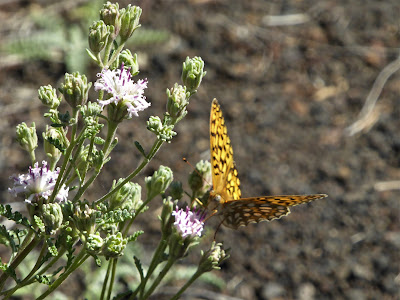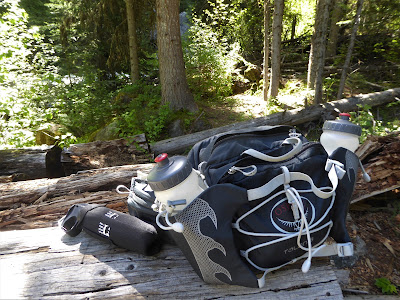Visiting southern Idaho
Boise, ID
We left Arizona three months ago and were in need of an oil change, haircut and a visit to the chiropractor. We used our three days in Garden City, ID to do that and had time for a little riverside bike ride. We found "The Joint" which is a nationwide network with 400 locations across the country works well for us. They can look at your chart online and see how you have been treated in the past and know of any potential problems. Dr. "O" was very good and got me back on the saddle again.
As we rode along the beautiful Boise River Greenbelt to downtown Boise and stopped to watch the river surfers, a news crew that had been filming the surfers and us approached us. The reporter asked if he could "mic" Mike and film us for their "Idaho Life" piece.
In the above clip you can see us in three 1-2 second blips starting at second 49. We got a kick out of watching glimpses of our self that night on the news. Don't blink.
It was great to have signs along the multiuse path telling us what was just off the path. The container off to the right was being transformed into a coffee house.
There were also restaurants as we got closer to downtown Boise.
Arco, ID
In 1955, tiny Arco won fame as the world’s first nuclear-powered city. The reason that the government chose this corner of eastern Idaho as one of its nuclear sandboxes being it is remote and sparsely-populated, Arco is the kind of place that a nuclear accident might go unnoticed. Or at least under-reported. Did you know that the USA’s only fatal nuclear accident occurred in Arco, Idaho? In 1961, there was a core meltdown in the National Reactor Testing Station which killed three servicemen.
 |
| Submarine Park |
Craters of the Moon National Monument
Craters of the Moon formed during eight major eruptive periods between 15,000 and 2000 years ago along the Great Rift for a lava flow of 618 sq miles long. More eruptions are expected in the future.
 Our visit to Craters of the Moon was chosen because there is not a lot out there in this section of Idaho and was good stopping place for a few days. We don't like to drive long distances. This turned out to be an interesting area.
Our visit to Craters of the Moon was chosen because there is not a lot out there in this section of Idaho and was good stopping place for a few days. We don't like to drive long distances. This turned out to be an interesting area. Pioneers used the Goodall Shortcut through this section of Idaho rather than along the Oregon Trail along the Snake River to avoid the Indians that were known to harass settlers. There are still wagon ruts along the way.
There were four caves in the park to explore once we got our permit at the visitors center.
On August 22, 1969, Apollo 14 astronauts Alan Shepard, Edgar Mitchell, Joe Engle, and Eugene Cernan landed at the airport in Arco. They then proceeded to Craters of the Moon where they explored the lava landscape and learned the basics of volcanic geology in preparation for future trips to the moon. Much of the moon's surface is covered by volcanic materials.
The wind was blowing so hard from the west yesterday. It seems to be the case frequently with trees growing like this.
Monkey flowers
The ability to grow in this harsh environment means overcoming a lack of moisture, meager soil, and surface temperatures that exceed 150 degrees Fahrenheit. In such a harsh environment, you wouldn't expect to see so many flowers and butterflies. We had arrived in time for the peak bloom in the middle of June.
Even though the air temperature was 68 degrees F, it got very hot hiking among the black lava rocks.
The area is a designated International Dark Sky Park.
Climbing a cinder cone.
There were butterflies everywhere. This one kept landing on me. He rode on my hat for a while.
We got an early start to avoid the crowds. The sunshine made it pretty warm but was much cooler in the caves.
Buffalo Cave
We are going in after putting on our headlamps.
Mike's third eye headlamp.
Indian Tunnel
We had to watch our step over the boulders.
Climbing out.
 |
| Trail markers to get back to the other trail. |
EBR I
We had a short 70 mile drive to Idaho Falls before heading to Wyoming. Roadside America suggested a stop at this museum. A little different than the power plant from which Mike retired.
 |
| Experimental Breeder Reactor I the world's first nuclear power plant |
This museum along highway 20 on the way to Idaho Falls was where scientists first created usable amounts of electricity by splitting the atom. The intern leading the tour was very interesting going back to 1951 including stories about the people involved in the development and working of this nuclear energy. It was much better than the self guided tour that was also available.
We looked through windows to see the stainless steel tank that comprised the core. It was kind of an eerie place.
Heading to the Grand Tetons....





























































